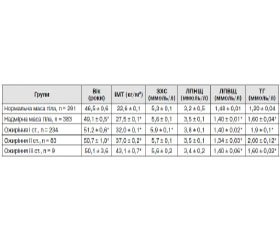Международный эндокринологический журнал 5 (69) 2015
Вернуться к номеру
The prevalence of lipid disorders in urban population of Ukraine depending on the degree and type of obesity
Авторы: Mitchenko O.I. - SI NSC "M.D. Strazhesko Institute of cardiology, NMAS of Ukraine"; Mammedov M.N. - SI "State Research Center for Preventive Medicine," The Ministry of Health, Moskow; Kolesnik T.V. - SI "Dnipropetrovsk Medical Academy" The Ministry of Health, Ukraine, Dnipropetrovsk; Deev A.D. - SI "State Research Center for Preventive Medicine," The Ministry of Health, Moskow; Romanov V.Y., Kulyk O.Y., Shkreba A.A. - SI NSC "M.D. Strazhesko Institute of cardiology, NMAS of Ukraine", on behalf of the Working Group of the Russian-Ukrainian research of 20 risk factors in Dnipropetrovsk
Рубрики: Эндокринология
Разделы: Справочник специалиста
Версия для печати
epidemiology, overweight, obesity, lipid disorders
Purpose: Subanalysis of the prevalence and detection of lipid disorders among the cohort of respondents with overweight and obesity, depending on the degree and type of obesity in a large population within the definition of risk factors in our research of Ukraine on urban population in 2009-2013.
Methods: The study protocol included the definition and evaluation of the 20 factors of cardiovascular risk of 1000 respondents (468 men and 532 women) at the age 30-69 years living in 5 regions of Dnipropetrovsk and subanalysis contained in this publication concerned the prevalence and detection of lipid disorders, depending on the degree and type of obesity. The following methods were used in this research: body mass index (BMI), waist circumference (WC), blood lipid profile.
Results: The population study conducted that the hypercholesterolemia was detected in 69.4% of patients, the gender distribution in 62.3% of men and 71.8% women. We analyzed the prevalence of dyslipidemia in urban populations depending on body weight and age. Among surveyed with normal body weight (291 people), hypercholesterolemia was diagnosed in146 respondents is 50.2%.
An increase was noted hypercholesterolemia identify respondents with normal weight at age aspect.
Thus, the respondents in the age group of 30-39, which included 97 people, hypercholesterolemia detected in 40 people, which is 41.2%; aged of 40-49 years, which included 65 respondents, hypercholesterolemia was diagnosed in 33 people, which is 50.8%; in the age group 50-59 years, which included 90 people, hypercholesterolemia detected in 54, which is 60%, and in the age group 60-69 years, which included 39 people, hypercholesterolemia was found in 19 respondents, which is 48, 7%. Among those overweight (383 respondents), the 163 (42.6%) identified hypercholesterolemia. The respondents overweight in the age group of 30-39, which included 90 people, hypercholesterolemia detected in 27, 30%; in the age cohort 40-49, which included 95 respondents, 42 registered hypercholesterolemia, which is 44.2% of the patients; in the age group 50-59 years, which included 130 people in 64 identified hypercholesterolemia, which is 49.6%; and at the age of 60-69 years which included 68 respondents, 30 identified hypercholesterolemia, hence the prevalence of hypercholesterolemia was 43.5%. Among people with obesity I degree (234 respondents), 87 (37.1%) identified hypercholesterolemia. Respondents with obesity and degree in the age group 30-39, which included 40 people, hypercholesterolemia was found in 18, which is 45% ; at the age of 40-49 years, which included 49 respondents, 18 identified hypercholesterolemia, which was 36%; in the age group 50-59 years, which came 101 respondents, 34 identified hypercholesterolemia, which is 33.3%; and at the age of 60-69 years, which included of 45 people found in hypercholesterolemia and 18 respondents was 40%. Among people with obesity II degree (83 respondents), 22 (26.5%) identified hypercholesterolemia. Respondents with obesity II degree in the age group 30-39, which included 13 respondents, hypercholesterolemia detected in 5 (38.5%); in the age cohort 40-49, which included of 19 people found 3 hypercholesterolemia, which is 15.8%; in the age group 50-59 years, which included 38 respondents, hypercholesterolemia detected in 24 and is 63.2%; and at the age of 60-69 years, which included 13 people, hypercholesterolemia detected in 3, which is 23.1%.Among people with obesity III degree (9 respondents) found in 3 hypercholesterolemia, which is 33.3%. A similar analysis conducted on the basis of gender differences, and in groups of overweight and different degrees of obesity. We analyzed the detection of hypertension in urban population Ukraine according to the type of obesity. The results were analyzed according to the type of abdominal obesity defined by the criteria AНA (2013) and ESC (2012).
Conclusions: We have determined that in the analyzed urban population of Ukraine's population normal weight had only 29.3% of the population and 70.7% had total overweight and obesity I-III degree, the percentage of detection of hypercholesterolemia in the population amounted to 69.4%, with all manifestations of disorders of lipid metabolism increased with increasing degree of obesity and age. It was found that, in parallel with an increase in body weight an increase in detection of isolated hypertriglyceridemia against reduction detection percent isolated hypercholesterolemia, which is due to redistribution in parallel with an increase in BMI, lipid disorders by increasing the percentage of detection combined dyslipidemia from 7.9% at normal body weight to 44 4% for obesity III degree. It was found that in men, the appearance and progression of abdominal type of obesity is associated with increased detection of lipid disorders, while women of similar clear pattern was found.

